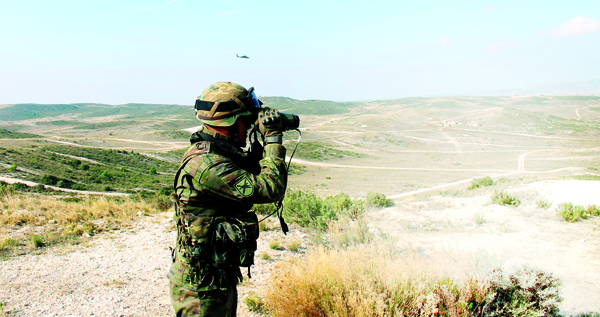- Home
- Feature Articles
- La Brigada 2035 abre fuego
2035 Brigade opens fire
Wednesday, January 2, 2019
Number: 72

The concept of 'fire' gathers a number of activities aimed at destroying, neutralising or affecting the enemy. It includes both indirect fire—in which there is no direct line of sight between the origin of the fire and the target—and the use of electromagnetic energy with offensive purposes.
In relation with indirect fire in future settings, specific terrestrial fires will be key due to their capacities (short reaction time, continuity in support, fire mass and precision) that make possible a large number of effects.
Also, generally speaking, the future indirect fire system will be able to integrate the Army firing capacities, and in the joint and combined field, identify, locate and acquire targets with a great discrimination power: use versatile fire, have responsiveness and be able to distribute fire for decentralised operations. In the target acquisition field, active and passive sensors as well as supplementary capacities (radar, sound, optronic, infrared) both on terrestrial or air platforms (remote or autonomous) will be necessary.

Two of their main requisites will be reach and precision, both in line with those of the fire producing means they support. For instance, the increasing relevance the GPS-guided precision ammunition (with a circular error probability from 2 to 5 metres) will force to reduce even more the error in the target location for this kind of ammunition.
The future terrestrial forces will have to integrate joint fires at a lower level, which will imply a reinforcement of the units with more joint terminal attack controllers (JTAC) in Tactical Group and in lower levels. JTAC is certified and qualified to lead aircrafts in close air support actions (CAS), providing terminal attack control. For this purpose, it will hace digital systems supporting CAS, contributing to airspace management. This activity will be increasingly important in a future airspace more and more crowded.
WEAPON SYSTEMS
Future weapon systems will have topographical and ballistic autonomy (integrating positioning, orientation and calculation of ballistic data skills) to make their deployment and use more flexible, increase surveillance at the battlefield and reduce structures in the fire support units. Moreover, they will increase automation and efficiency, thus reducing the personnel needs.
The rise in reach will be possible thanks to the progress both in weapon systems and in the ammunition field, allowing a considerable increase in support capacities and in the surveillance degree of the platforms. Thus, to support a Brigade, it would be necessary 120mm mortars with 10-15 km reach, 155 mm cannon artillery with 40-50 km reach, and rocket artillery with 100-120 km reach.
Furthermore, from an organisational perspective, the articulation of indirect fire structures combining different weapon systems (mortar, cannon, rocket) will permit a greater response flexibility.

AMMUNITION
The main requisites for ammunition will be in the fields of precision and reach. The availability of a great variety of non-lethal ammunition (fumes, sprays, carbon fibres...) will increase the effects to be reached in settings in which due to several reasons (legal, political or social) the use of lethal ammunition is not possible or convenient.
Precision ammunition will be particularly used in urbanised areas or when collateral damage is to be prevented. They will increase efficiency with an important impact on logistics, as they reduce considerably the necessary amount of artillery ammunition. For its part, the so-called loitering ammunition will make mission-abort possible in case the target is not detected or the desired conditions for the attack are not met.
Finally, in the command and control field, the indirect fire units will have to be efficiently integrated into the operative organisations, thus contributing to generate a wide range of effects, with minimal risk of fratricide or collateral damage. Therefore, it is necessary to integrate the system constituted by sensors, weapon systems and command and control elements in the so-called 'net fires'.
Regarding the use of electromagnetic energy with offensive purpose, it will be necessary to use technologically advanced systems that permit the distmantling of the enemy telecommunication and non-telecommunication systems when required, including the availability of light jammers in support of small units.
ARMY UNITS
- Araba Álava |
- Albacete |
- Alicante |
- Almería |
- Asturias |
- Ávila |
- Badajoz |
- Barcelona |
- Burgos |
- Cáceres |
- Cádiz |
- Cantabria |
- Castellón |
- Ceuta |
- Ciudad Real |
- Córdoba |
- A Coruña |
- Cuenca |
- Girona |
- Granada |
- Guadalajara |
- Gipuzkoa |
- Huelva |
- Huesca |
- Islas Baleares |
- Jaén |
- León |
- Lleida |
- Lugo |
- Madrid |
- Málaga |
- Melilla |
- Murcia |
- Navarra |
- Ourense |
- Palencia |
- Las Palmas |
- Pontevedra |
- La Rioja |
- Salamanca |
- Segovia |
- Sevilla |
- Soria |
- Tarragona |
- Santa Cruz de Tenerife |
- Teruel |
- Toledo |
- Valencia |
- Valladolid |
- Bizkaia |
- Zamora |
- Zaragoza



